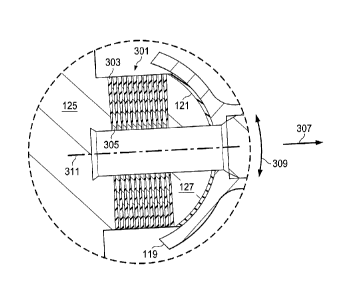Une partie des informations de ce site Web a été fournie par des sources externes. Le gouvernement du Canada n'assume aucune responsabilité concernant la précision, l'actualité ou la fiabilité des informations fournies par les sources externes. Les utilisateurs qui désirent employer cette information devraient consulter directement la source des informations. Le contenu fourni par les sources externes n'est pas assujetti aux exigences sur les langues officielles, la protection des renseignements personnels et l'accessibilité.
L'apparition de différences dans le texte et l'image des Revendications et de l'Abrégé dépend du moment auquel le document est publié. Les textes des Revendications et de l'Abrégé sont affichés :
| (12) Brevet: | (11) CA 2790085 |
|---|---|
| (54) Titre français: | COUSSINET ELASTOMERE AVEC CALES EFFILEES |
| (54) Titre anglais: | ELASTOMERIC BEARING WITH TAPERED SHIMS |
| Statut: | Octroyé |
| (51) Classification internationale des brevets (CIB): |
|
|---|---|
| (72) Inventeurs : |
|
| (73) Titulaires : |
|
| (71) Demandeurs : |
|
| (74) Agent: | NORTON ROSE FULBRIGHT CANADA LLP/S.E.N.C.R.L., S.R.L. |
| (74) Co-agent: | |
| (45) Délivré: | 2015-11-03 |
| (22) Date de dépôt: | 2012-09-13 |
| (41) Mise à la disponibilité du public: | 2013-04-03 |
| Requête d'examen: | 2012-09-13 |
| Licence disponible: | S.O. |
| (25) Langue des documents déposés: | Anglais |
| Traité de coopération en matière de brevets (PCT): | Non |
|---|
| (30) Données de priorité de la demande: | |||||||||
|---|---|---|---|---|---|---|---|---|---|
|
Le coussinet de force centrifuge comprend une pluralité de cales métalliques effilées de sorte que lextrémité plus épaisse de chaque cale métallique effilée se trouve proche de la partie intérieure du coussinet. Le coussinet peut comprendre une pluralité déléments élastomères effilés qui sont par conséquent effilés de manière à ce que les parties intérieures soient plus étroites que les parties extérieures. Les cales métalliques effilées peuvent accroître la rigidité axiale dans le sens de la force centrifuge, réduisant ainsi la déflexion axiale sous la charge, comparativement à des cales non effilées. En outre, réduire la déflexion axiale réduit les problèmes de dégagement qui peut survenir quand on permet à lailette de rotor à fléchir axialement sur des distances importantes. Comme telles, les cales métalliques effilées peuvent augmenter la capacité du coussinet. Effiler les cales métalliques peut réduire la déformation de cisaillement induite par la compression à proximité des parties extérieures de lélément élastomère, là où les charges sont habituellement plus élevées.
The centrifugal force bearing includes a plurality of tapered metal shims such that the thicker end of each tapered metal shim near the inner portion of bearing. The bearing can include a plurality of tapered elastomeric members that are consequently tapered so that the inner portions are narrower than the outer portions. The tapered metal shims can increase the axial stiffness in the direction of the centrifugal force, thereby reducing the axial deflection under loading, as compared to non-tapered shims. Further, reducing axial deflection reduces clearance issues that may arise when the rotor blade is allowed to axial deflect significant distances. As such, the tapered metal shims can increase the capacity of the bearing. Tapering the metal shims can decrease the compression induced shear strain near the outer portions of the elastomeric member, where loads are typically higher.
Note : Les revendications sont présentées dans la langue officielle dans laquelle elles ont été soumises.
Note : Les descriptions sont présentées dans la langue officielle dans laquelle elles ont été soumises.

Pour une meilleure compréhension de l'état de la demande ou brevet qui figure sur cette page, la rubrique Mise en garde , et les descriptions de Brevet , États administratifs , Taxes périodiques et Historique des paiements devraient être consultées.
| Titre | Date |
|---|---|
| Date de délivrance prévu | 2015-11-03 |
| (22) Dépôt | 2012-09-13 |
| Requête d'examen | 2012-09-13 |
| (41) Mise à la disponibilité du public | 2013-04-03 |
| (45) Délivré | 2015-11-03 |
Il n'y a pas d'historique d'abandonnement
Dernier paiement au montant de 263,14 $ a été reçu le 2023-09-08
Montants des taxes pour le maintien en état à venir
| Description | Date | Montant |
|---|---|---|
| Prochain paiement si taxe générale | 2024-09-13 | 347,00 $ |
| Prochain paiement si taxe applicable aux petites entités | 2024-09-13 | 125,00 $ |
Avis : Si le paiement en totalité n'a pas été reçu au plus tard à la date indiquée, une taxe supplémentaire peut être imposée, soit une des taxes suivantes :
Les taxes sur les brevets sont ajustées au 1er janvier de chaque année. Les montants ci-dessus sont les montants actuels s'ils sont reçus au plus tard le 31 décembre de l'année en cours.
Veuillez vous référer à la page web des
taxes sur les brevets
de l'OPIC pour voir tous les montants actuels des taxes.
Les titulaires actuels et antérieures au dossier sont affichés en ordre alphabétique.
| Titulaires actuels au dossier |
|---|
| BELL HELICOPTER TEXTRON INC. |
| Titulaires antérieures au dossier |
|---|
| S.O. |